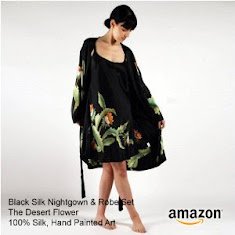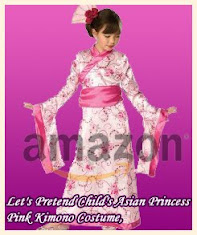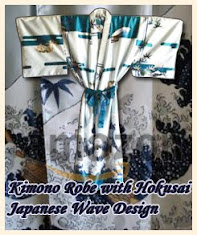The selection of the appropriate kimono requires knowledge of the symbolism and subtle cues that contained each type of kimono. The level of formality is determined by the woman's kimono fabric patterns and colors, ranging from the most formal kimono to kimono casually. Based on the type worn kimono, kimono can show the user age, marital status, and level of formality of the event attended.
* Kurotomesode
Tomesode is the most formal kimono for married women. If the black robe of this type is called kurotomesode (literally: black tomesode). Family symbol Kurotomesode (kamon) in three places: 1 in back, 2 in the upper chest (right / left), and 2 rear arm (right / left). Characteristic motifs kurotomesode is beautiful on suso (the bottom around the foot) front and rear. Kurotomesode used to attend wedding receptions and events that are formal.
The girl wore furisode
* Irotomesode
Tomesode made of colored cloth called irotomesode (literally: tomesode color). Depend on the level of formality of the event, the user can select the number of family coat of arms on a kimono cloth, ranging from one, three, up to five pieces for a very formal event. This type of kimono worn by adult women who have / have not married. Kimono irotomesode type used to attend an event that does not allow guests to come wearing kurotomesode, such as a reception at the imperial court. Just as kurotomesode, irotomesode characteristic is beautiful in suso motive.
* Furisode
Furisode is the most formal kimono for young women who have not married. Material brightly colored with conspicuous pattern throughout the fabric. Furisode characteristic is part of a very wide sleeves, and hanging down. Worn when attending Furisode permission shiki ceremony, attended a friend's wedding reception, graduation ceremony, or Hatsumōde. Trousseau called hanayome ishō including one of furisode.
* Homongi
Hōmon-gi (literally: a dress for a visit) is a formal kimono for women, married or not married. Users are free to choose to wear featuring material family emblem or not. Homongi are characteristic motifs in all parts of the cloth, front and rear. Homongi used as a guest of a wedding reception, tea ceremony, or celebrate the new year.
* Iromuji
Iromuji is semiformal kimono, but it could be a formal kimono if it has the symbol iromuji family (kamon). In accordance with the level of formality kimono, coat of arms could have 1, 3, or 5 places (the back, the arms, and the chest). Iromoji not made of patterned and colored materials soft, pink, light blue, or pale yellow or soft colors. Iromuji with the family coat of arms can be worn 5 places to attend the wedding. When you attend a tea ceremony, is used iromuji with a coat of arms.
* Tsukesage
Tsukesage is semiformal kimono for women who have or have not married. According to the level of formality, tsukesage position just below homongi level. This type of kimono has no coat of arms. Tsukesage charged to attend the tea ceremony is not so formal, wedding, formal party, or celebrating the new year.
* Komon
Komon is relaxed kimono for women who have or have not married. Characteristic of this type of kimono is a simple motive and the small size of berulang.Komon charged to attend the reunion party, dinner, meet friends, or watching a show at the building.
* Tsumugi
Tsumugi is relaxed kimono for everyday wear at home by a woman who has or has not married. However, this type of kimono worn allowed to leave the house such as shopping and a walk. The material used is a simple-woven fabrics of cotton or silk yarn thick low class and rude. This type of kimono durable, and was once worn to work in the fields.
* Yukata
Yukata is a casual kimono made of light cotton fabric without coating for a chance to relax in the summer.
* Kurotomesode
Tomesode is the most formal kimono for married women. If the black robe of this type is called kurotomesode (literally: black tomesode). Family symbol Kurotomesode (kamon) in three places: 1 in back, 2 in the upper chest (right / left), and 2 rear arm (right / left). Characteristic motifs kurotomesode is beautiful on suso (the bottom around the foot) front and rear. Kurotomesode used to attend wedding receptions and events that are formal.
The girl wore furisode
* Irotomesode
Tomesode made of colored cloth called irotomesode (literally: tomesode color). Depend on the level of formality of the event, the user can select the number of family coat of arms on a kimono cloth, ranging from one, three, up to five pieces for a very formal event. This type of kimono worn by adult women who have / have not married. Kimono irotomesode type used to attend an event that does not allow guests to come wearing kurotomesode, such as a reception at the imperial court. Just as kurotomesode, irotomesode characteristic is beautiful in suso motive.
* Furisode
Furisode is the most formal kimono for young women who have not married. Material brightly colored with conspicuous pattern throughout the fabric. Furisode characteristic is part of a very wide sleeves, and hanging down. Worn when attending Furisode permission shiki ceremony, attended a friend's wedding reception, graduation ceremony, or Hatsumōde. Trousseau called hanayome ishō including one of furisode.
* Homongi
Hōmon-gi (literally: a dress for a visit) is a formal kimono for women, married or not married. Users are free to choose to wear featuring material family emblem or not. Homongi are characteristic motifs in all parts of the cloth, front and rear. Homongi used as a guest of a wedding reception, tea ceremony, or celebrate the new year.
* Iromuji
Iromuji is semiformal kimono, but it could be a formal kimono if it has the symbol iromuji family (kamon). In accordance with the level of formality kimono, coat of arms could have 1, 3, or 5 places (the back, the arms, and the chest). Iromoji not made of patterned and colored materials soft, pink, light blue, or pale yellow or soft colors. Iromuji with the family coat of arms can be worn 5 places to attend the wedding. When you attend a tea ceremony, is used iromuji with a coat of arms.
* Tsukesage
Tsukesage is semiformal kimono for women who have or have not married. According to the level of formality, tsukesage position just below homongi level. This type of kimono has no coat of arms. Tsukesage charged to attend the tea ceremony is not so formal, wedding, formal party, or celebrating the new year.
* Komon
Komon is relaxed kimono for women who have or have not married. Characteristic of this type of kimono is a simple motive and the small size of berulang.Komon charged to attend the reunion party, dinner, meet friends, or watching a show at the building.
* Tsumugi
Tsumugi is relaxed kimono for everyday wear at home by a woman who has or has not married. However, this type of kimono worn allowed to leave the house such as shopping and a walk. The material used is a simple-woven fabrics of cotton or silk yarn thick low class and rude. This type of kimono durable, and was once worn to work in the fields.
* Yukata
Yukata is a casual kimono made of light cotton fabric without coating for a chance to relax in the summer.
04.58 |
Category: |
0
komentar

.jpg)




.jpg)
.jpg)
.jpg)
.jpg)
.jpg)
.jpg)
.jpg)
.jpg)


Comments (0)